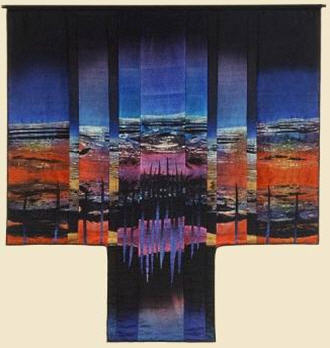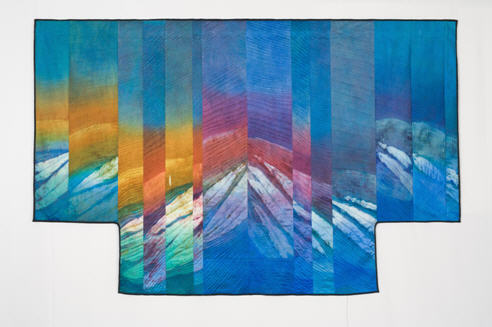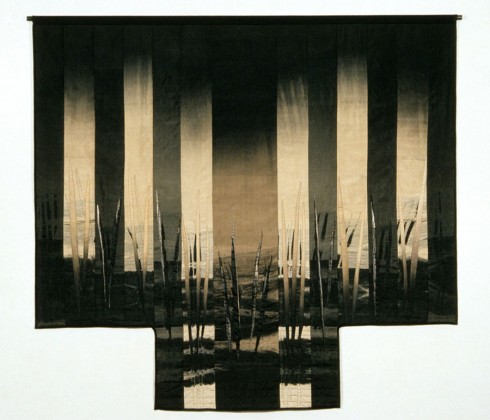Marisma “Salt March”
2003 is made from silk and Judith’s own arashi shibori technique. This kimono-shaped art quilt is a departure from Judith’s well known layers of bright and vivid colors. However, Marisma has the watercolor feel which is characteristic of Judith’s signature technique, dominated by sepia tones.
Content has been an artist for more than thirty years, starting with training in painting to being a student of Japanese shibori and branching out to many other mediums. Highly skilled in the dyeing arts, Judith has developed her own arashi (pole wrapping) shibori technique that subtracts and adds color. This approach produces a unique and calming effect, attractive to the eye, regardless of the piece’s size. Her works are installed in many institutions around the world. In the recent past Judith was President of the Studio Art Quilts Associates (www.saqa.com), and is still very active in the organization. Judith will have a solo exhibition at Santa Fe’s Jane Sauer Gallery next October.
I visited Judith at her home in the South Bay. Walking into her home is like being in a painting – everything artfully arranged, with bright-colored walls and an outdoor garden that is an artist’s palate, very much like the colors in a Matisse. Her studio is impeccably placed, from the tidy collection of threads stored in wall-mounted shelving, to the dyeing area located outside. We spoke about her work and inspiration under the careful watch of her cat, Pearl.
CC: Marisma “Salt Marsh” has the feeling of looking through a time lens – the contrast striping makes me think of a city skyline, and yet the marshes are very clearly the center of focus. How did that evolve while you were working on this piece?
JC: At the de Young it is fun to see the way Marisma is displayed – the lighting is very effective. It often happens in my work, that it evokes personal memories for different people. In Marisma, I was not thinking of a city at all, but creating a gradation of light across the horizon with the stripes. I am interested in color gradations wherever they occur – tomatoes in the garden, colors in the sky. My work tends to be symmetrical, but this piece is not like that at all.
My process is very hands on – like origami. I work with leaf and grass shapes, curving and making the fabric do what it might not necessarily want to do! Marisma started out black and was discharged. The ABS poles I use to wrap the fabric must be kept in motion at all times. That is how I can create a gradation at the top – white to grey to black, constantly dipping. I have learned not to hurry the process. If I just discharge the exposed surface of the pole, using the same process will yield something different. I also use multiple colors by pouring the dye over the surface of the pole, which yields a complex result.
I am trained as a painter. When I pleat and discharge, I am dyeing with a piece in mind – but I also need spontaneity and intuition. It becomes a cross between 30 years, plus years of experience and looking and seeing what’s happening.

"Precipice" photo courtesy of the artist
My most recent piece – Cataclysm – was inspired by the Krakatoa volcano eruption that was heard half way round the world in 1883. I had visualized the vivid reds and oranges phasing into the darkest blues. A few days after the piece was done the Iceland eruption occurred. It was quite a coincidence! Cataclysm will be in the Visions exhibit in San Diego, starting October 2010 http://www.quiltvisions.org/calendar.asp# . I will be moderating a panel “Balancing Act: The Art of Being an Artist” during the opening festivities. Precipice and Chasm are both in private collections: Chasm is in the collection of the San Jose Museum of Quilts and Textiles.
CC: When you developed your own arashi shibori technique, did you have quilting in mind, or did they just come together?
JC: For me, the quilting is a means to an end – it’s the effect that I get. Since I was never taught how to quilt, I am not following any rules. Originally I started using quilting because I could only dye small pieces – on broom handles. Sewing pieces together was the means to make the project bigger. I later moved to using jug/wine bottles. When I worked on multiple story commissions, multiple panels were the means to an end for creating a bigger piece.
I also find that the quilting/piecing technique is practical – like collage. Something special happens in the juxtaposition of the color and design of the pieces – if I dyed a single big piece I would not get that same effect. That is the nature of collage – finding the unexpected relationships and dynamics when bringing the pieces together. And although the kimono is a typical ethnic shape, it really suits my message. I have worked with rectangles, but when I use the kimono shape it creates an energy I can’t define.
I use the quilting as I would use a pen or pencil, and most often I use black as a base because it outlines and defines patterns. I can punch up an area to draw the eye there, or to diffuse other areas. Cataclysm has areas where the quilting is a sixteenth of an inch apart and that creates an amazing texture. The lines are expressive and speak for themselves. Ultimately the piece talks to what it wants to do and you do what you have to do to get there.

"Cataclysm" photo courtesy of the artist
CC: You are well known for using the California coast as your subject in many of your works. Do you have other sources of inspiration?
JC: I had no clue I was well known for using the landscape. My inspiration source is everything! I thought I wouldn’t have any inspiration when I left the academic environment. Instead, I have realized that there’s not enough time in the day to make everything I want to – it’s like a working a 24 hour day! Sometimes I observe cliffs. My most recent inspiration was in New Mexico where the Rio Grande is being allowed to flood where it would normally run through. Or my inspiration could be just a tiny detail – like a sand pattern at a beach.
In my studio, I need to work in a clean, tidy environment. That is directly opposite from my mother, who is still a full time artist in Japanese brush painting. We are very supportive of each other, but she needs to be in total chaos when she works. But she always knows where everything is! My daughter is a pastry chef – an artist with food! She creates beautiful combinations of flavor and color.
I have weathered a lot of recessions over time, and they have created opportunities that have impacted my art. For instance, I had worked with industry art brokers using mostly mauve and teal. Then the recession in the 80’s turned out to be a friend – the art broker work dried up. My pieces got smaller and more dramatic and more colorful and brought me in a whole new direction.
CC: I found a quote from a blogger who described being inspired by you to create quilts, because your “works are perfect, zen, and beautiful and I can scarcely tear my eyes away from them.” How does it feel to be such a source of inspiration?
JC: I was thrilled! I wrote back to her and I think she was a little overwhelmed. It was especially gratifying since she hadn’t seen them in person. The nature of textiles is to be able to see the beauty of the pieces in person. Good photographers can try and capture the surface of the design, but it isn’t the same.
CC: What kind of encouragement would you give to the fledging artist and those that know technique but lose inspiration?
JC: If you are really starting in at the beginning, you have to realize that the first
piece is not perfect, it’s the start of a journey. If you see the parts are a success, go with the parts that excite you. People are generally always in a hurry – it takes time to find the voice and the parts.
You can learn more about Judith at http://www.kentuckyarts.org/landscapes/Judith%20Content.htm
and http://www.allianceforamericanquilts.org/qsos/show_interview.php?pbd=qsos-a0a8h1-a
To see more, go to Analisa
